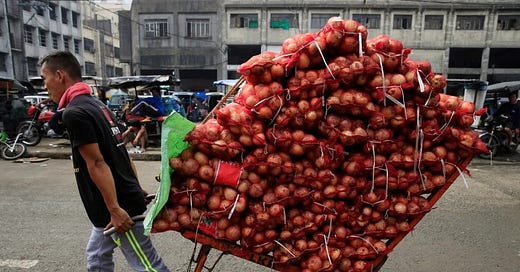Philippines’ Marcos Faces Second Agriculture Crisis
President’s takeover of agriculture portfolio reaps embarrassment as onions disappear
By: Viswa Nathan
Before President Ferdinand Marcos Jr. had even completed his first six months in office, a second crisis – again in the Department of Agriculture, which he has taken under his direct management as agriculture secretary – is casting a dark shadow over his administration. Onions have mysteriously disappeared across the country, raising suspicions a cartel is manipulating supply to drive up prices although officials and farmers deny it. Meanwhile, the president is on his fifth trip outside the country since he took office, a three-day state visit to China that began on January 3.
In August, Marcos’s second month in office, a sugar scandal erupted when two executives signed an order to import 300,000 metric tons, allegedly to curb sugar’s rising retail price, but without the president’s authorization, showing how easy it was to circumvent the chain of command. But Marcos canceled the sugar import authorization. A few heads also rolled, by suasion or voluntary resignation, while surprise inspections of sugar traders’ warehouses discovered vast quantities of sugar in stock. Some say the entire episode was stage-managed to clean up the department. If so, the planning and handling of the crisis were creative and commendable.
However, it now seems that the cleaning up has not gone far enough. Four months down the road, the administration is marred by another situation for which the agriculture department is responsible –the soaring price of the lowly vegetable, which nonetheless is an essential part of Filipino cuisine, and which has risen as much as seven times to over PHP700 (US$12.53) a kilo in a matter of weeks. In comparison, the price traders paid at the farmgate in November was said to be some PHP20-27 per kilo, recalling unpleasant impressions of Marcos’s late father Ferdinand’s administration, when prices were routinely manipulated by cartels.
Unlike in the sugar scandal, hoarding appears not to be the reason for onion scarcity and the price spiral. Even farmers’ organizations like the Samahang Industriya ng Agrikultura (Sinag) rule out hoarding. “There is really a shortage” in the supply chain, Sinag President Rosendo So told reporters at the end of November. The shortage is nothing new. The country has been experiencing it every year for a long time due to inadequate local production, but the shortfall is met regularly by timely importation. It held supply and retail prices reasonably stable.
The president of the Philippine Chamber of Agriculture and Food, Inc., Danilo Fausto, also told local media: “We failed to import, that is why we are short of supply.”
The 2022 shortfall in local production was estimated at 40-50,000 metric tons. Imports to cover this shortfall, Fausto said, should have been ordered in July and August. The Department of Agriculture has tried to blame major suppliers for hoarding to jack up the price. But Fausto questions it. Hoarding, he says, is not a sensible option; it’s a losing endeavor because the shelf life of the root vegetable isn’t long enough. Onions can be held in cold storage for up to 10 months without deteriorating.
October-December is the onion-planting season for harvesting in the following February-April. Sinag said it had advised the department well ahead in October to import some 7,000 mt white onions and 7,500 mt red onions to cover local production shortfall in 2022. In the last quarter of 2021, the country imported 46,300 mt.
According to So, the Bureau of Plant Industry (BPI) under the Department of Agriculture also can monitor local production, gauge shortfall, and recommend importation, as in past years, to meet market demand and ensure price stability.
If timely actions were taken and the goods released to the market as demand perked, prices would have remained more or less stable with essential inflation adjustments. But Sinag’s advice fell on deaf ears. The DA spokesperson, Agriculture Undersecretary Kristine Evangelista, told lawmakers in August that the DA decided against issuing permits for another round of white onion imports to prevent forcing farmgate prices down.
Still, the chasm between the price suppliers paid at the farmgate and the current retail price is offensively wide. Farmers received 20-27 pesos a kilo, while the current retail price varied between 450 and more than 700 per kilo, depending on the region. The DA has suggested a price cap of 250 pesos per kilo for the first week of January 2023, way above the price level before the onion crisis began. Whether the price cap will hold is doubtful in the face of the prevailing supply shortage. According to housewives in some provincial markets, a piece of red onion as small as a shallot is sold at five pesos.
Farmers, said So, do not benefit from the price spiral, as they have sold their output to traders upon harvesting in February-April. Therefore, So suspects some bureaucrats are conniving with traders to manipulate supply for mutual benefit.
The president’s sister, Sen. Imee Marcos, who chairs the Senate committee on cooperatives, seems to agree with So’s thinking. The government-owned Philippine News Agency reported on December 1 that Imee Marcos claimed importation has been part of a cycle of price manipulation by traders in cahoots with corrupt officials in the DA and the Bureau of Customs.”
The sugar scandal and the onion crisis speak not only of the rapacious importers and traders and the corrupt officials that Imee Marcos spoke of. They also speak of the ill-thought initiatives taken in the past and the need for creative thinking and planning if President Marcos is to realize his aim to lift the country to upper middle-income status by raising Gross National Income (GNI) per capita to the equivalent of US$4,256 by 2024. That is now one year away. To do it, an all-enveloping agriculture policy has to be developed to make agriculture a profession attractive to the new generation of Filipinos.




